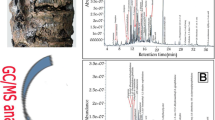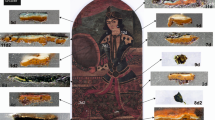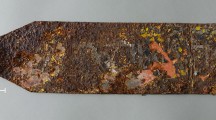Abstract
The resins and other biochemical substances in mixtures have an important role in achieving the preservation goal for mummification process. The identification of organic mixtures is vital in the conservation field of the unwrapped mummies, but their identification is sometimes difficult because of improper conditions, which can affect their structure and need good investigation techniques for their identification. Some endogenous or exogenous factors can cause some aspects of deterioration to organic mixtures such as cracks, color change, and chemical alteration. This study aims to evaluate the materials used for the preservation of the body in order for them to be re-used in the near future for the preservation processes on the unwrapped mummies in Egyptian museums and storehouses. Samples of organic mixtures were taken from an ancient Egyptian mummy dated to the Late Period (664–333 B.C.). A digital USB microscope and a scanning electron microscope (SEM) were used to identify the application method of the preservative mixtures used during the mummification process and to demonstrate the morphology of surface alteration on the body. Fourier transform infrared (FTIR) was used to detect the chemical changes. A portable X-ray fluorescence (XRF) was used to identify elements. The results revealed that the investigation by microscopes showed cracks in the mixtures poured inside the cranial cavity, but the application of these mixtures was by brush on the outer surface layer of the body. FTIR analysis revealed that a mixture of oil, animal fat, and resinous materials such as mastic and pine were present in the studied samples. Moreover, these samples were prone to oxidation processes through time. XRF analysis showed that the main chemical elements of the samples were calcium, potassium, phosphorus, chlorine, sulfur, and silicon and trace chemical elements such as iron, zinc, copper, and lead, which are in the chemical composition of pine and mastic resins.







Similar content being viewed by others
References
Abd Elhay RKI (2013) Next generation sequencing of DNA extracted from mummified tissue. Dissertation Ph.D. thesis, University of der EberhardKarls, Tübingen, Germany: 11
Abdel-Maksoud G, Abdel-Hady M (2011) Effect of burial environment on crocodile bones from Hawara excavation, Fayoum, Egypt. J Cult Herit 12:180–189
Abdel-Maksoud G, El-Amin A (2011) A review on the materials used during the mummification processes in Ancient Egypt. Mediterr Archaeol Archaeometry 11:129–150
Abdel-Maksoud G, El-Amin A (2013) The investigation and conservation of a gazelle mummy from the Late Period in ancient Egypt. Mediterr Archaeol Archaeometry 13:45–67
Anderson G, Fregni G (2009) Technology as a tool for archaeological research and artifact conservation. AIC Objects Specialty Group Post prints 16:95–109
Aufderheide AC, Cartmell L, Zlonis M, Sheldrick P (2004) Mummification practices at Kellis site in Egypt’s Dakhleh Oasis. Jssea 31:63–77
Ben-Yehoshua S, Ondřej Hanuš L (2014) Apharsemon, myrrh and olibanum: ancient medical plants. World Res J Med Aromat Plant 2:67–150
Boyer RS, Rodin EA, Grey TC, Connolly RC (2003) The skull and cervical spine radiographs of Tutankhamen: a critical appraisal. Am J Neuroradiol 24:1142–1147
Brettell RC, Schotsmans EMJ, Walton Rogers P, Reifarth N, Redfern RC, Stern B, Heron CP (2015) ‘Choicest unguents’: molecular evidence for the use of resinous plant exudates in late Roman mortuary rites in Britain. J Archaeol Sci 53:639–648
Brettell R, Martin W, Atherton-Woolham S, Stern B, McKnight L (2017) Organic residue analysis of Egyptian votive mummies and their research potential. Stud Conservat 62:1–15
Bruni S, Guglielmi V (2014) Identification of archaeological triterpenic resins by the non-separative techniques FTIR and 13C NMR: the case of Pistacia resin (mastic) in comparison with frankincense. Spectrochim Acta A 121:613–622
Buckley SA, Evershed RP (2001) Organic chemistry of embalming agents in Pharaonic and Graeco-Roman mummies. Nature 413:837–841
Carminati P, Begerock A-M, Gill-Frerking H (2014) Surface treatment of mummies: mummification, conservation or beautification. Yearbook of Mummy Studies 2:159–166
Colombini MP, Modugno F, Silvano F, Onor M (2000) Characterization of the balm of an Egyptian mummy from the seventh century B.C. Stud. Conservat 45:19–29
David A (2001) Benefits and disadvantages of some conservation treatments for Egyptian mummies. Chungará (Arica) 33:113–115
Derrick MR, Stulik D, Landry JM (1999) Infrared spectroscopy in conservation science. The Getty Conservation Institute, Los Angeles Chapter 6: 145
Facchetti F, Ribechini E, Betrò M, Colombini MP (2012) Organic residues analysis: the case of a beaker found in Theban necropolis, Egypt. Int J Conserv Sci 3:259–264
Izzo FC, Zendri E, Bernardi A, Balliana E, Sgobbi M (2013) The study of pitch via gas chromatography-mass spectrometry and Fourier-transformed infrared spectroscopy: the case of the Roman amphoras from Monte Poro, Calabria (Italy). J Archaeol Sci 40:595–600
Jackowski C, Bolliger S, Thali MJ (2008) Common and unexpected findings in mummies from ancient Egypt and South America as revealed by CT. Radiographics 28:1477–1492
Jahandideh M, Hajimehdipoor H, Mortazavi SA, Dehpour A, Hassanzadeh G (2016) A wound healing formulation based on Iranian traditional medicine and its HPTLC fingerprint. Iran J Pharm Res 15:149–157
Kavkler K, Frelih M (2013) Analysis of a Ptolemaic mummy foot from Slovene Ethnographic Museum. Procedia Chem 8:159–164
Khairat R, Ball M, Hsieh Chang C, Bianucci R, Nerlich AG, Trautmann M, Ismail S, Shanab GML, Karim AM, Gad YZ, Pusch CM (2013) First insights into the metagenome of Egyptian mummies using next-generation sequencing. J Appl Genet 54:309–325
Kłys M, Lech T, Zięba-Palus J, Białka J (1999) A chemical and physicochemical study of an Egyptian mummy ‘IsetIriHetes’ from the Ptolemaic period III–I B.C. Forensic Sci Int 99:217–228
Koller J, Baumer U, Kaup Y, Weser U (2005) Herodotus’ and Pliny’s embalming materials identified on Ancient Egyptian mummies. Archaeometry 47:609–628
Lucas A (1937) Notes on myrrh and stacte. JEA 23:27–33
Mahmoudi M, Ebrahimzadeh MA, Nabavi SF, Hafezi S, Nabavi SM, Eslami SH (2010) Antiinflammatory and antioxidant activities of gum mastic. Eur Rev Med Pharmacol Sci 14:765–769
McGovern PE, Hall GR (2016) Charting a future course for organic residue analysis in archaeology. J Archaeol Method Th 23:592–622
McKnight LM, Atherton-Woolham SD, Adams JE (2015) Imaging of ancient Egyptian animal mummies. Radiographics 35:2108–2120
Nigatu M (2014) Myrrh resin (Commiphora myrrha) as rate controlling excipient in sustained release matrix tablets of theophylline: evaluation, formulation and optimization study. Master thesis, School of Pharmacy, Department of Pharmaceutics and social Pharmacy, Addis Ababa University, Addis Ababa, Ethiopia: 13
Özen AC, Ludwig U, Öhrström LM, Rühli FJ, Bock M (2016) Comparison of ultrashort echo time sequences for MRI of an ancient mummified human hand. Magn Reson Med 75:701–708
Rousis NI, Pasias IN, Thomaidis NS (2014) Attenuation of interference in collision/reaction cell inductively coupled plasma mass spectrometry, using helium and hydrogen as cell gases—application to multi-element analysis of mastic gum. Anal Methods 6:5899–5908
Shen T, Li GH, Wang XN, Lou HX (2012) The genus Commiphora: a review of its traditional uses, phytochemistry and pharmacology. J Ethnopharmacol 142:319–330
Smith MJ, Kneller P, Elliott D, Young C, Manley H, Osselton D (2012) Multidisciplinary analysis of a mummified cranium claimed to be that of a medieval execution victim. Archaeol Anthropol Sci 4:75–89
Soy AS, Öhrström C (2013) Investigation and evaluation of methods for measuring surface texture on worktops and kitchen fronts. Master Thesis, Department of Design Science - Faculty of Engineering LTH -Lund University, Sweden: 12
Vahur S, Kriiska A, Leito I (2011) Investigation of the adhesive residue on the flint insert and the adhesive lump found from the Pulliearly Mesolithic settlement site (Estonia) by micro-ATR-FT-IR spectroscopy. Estonian Journal of Archaeology 15:3–17
Zareva S, Kuleff I (2010) The application of the derivative IR-spectroscopy and HPLC–ESI-MS/MS in the analysis of archaeology resin. Spectrochim Acta A 76:283–286
Zesch S, Panzer S, Rosendahl W, Nance Jr JW, Schönberg SO, Henzler T (2016) From first to latest imaging technology: revisiting the first mummy investigated with X-ray in 1896 by using dual-source computed tomography. Eur J Radiol Open 3:172–181
Author information
Authors and Affiliations
Corresponding author
Rights and permissions
About this article
Cite this article
Abdel-Maksoud, G., El-Shemy, H. & Abdel-Hamied, M. Investigation methods for evaluating the preservative organic mixtures applied on a Late Period mummy. Archaeol Anthropol Sci 11, 1843–1850 (2019). https://doi.org/10.1007/s12520-018-0633-7
Received:
Accepted:
Published:
Issue Date:
DOI: https://doi.org/10.1007/s12520-018-0633-7




